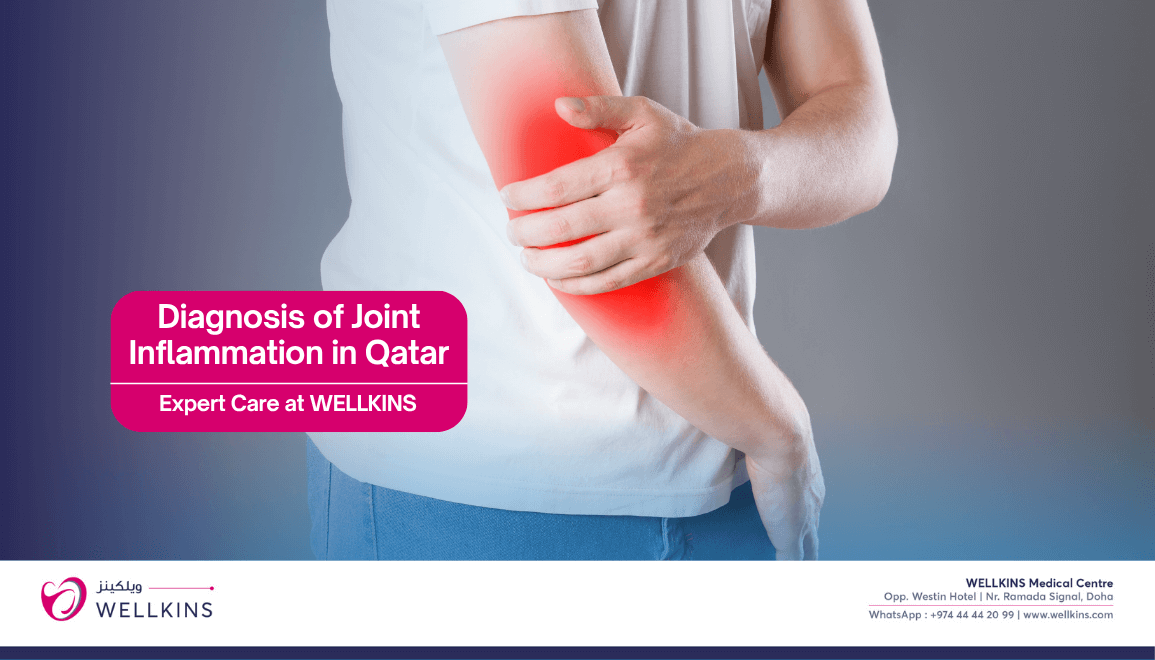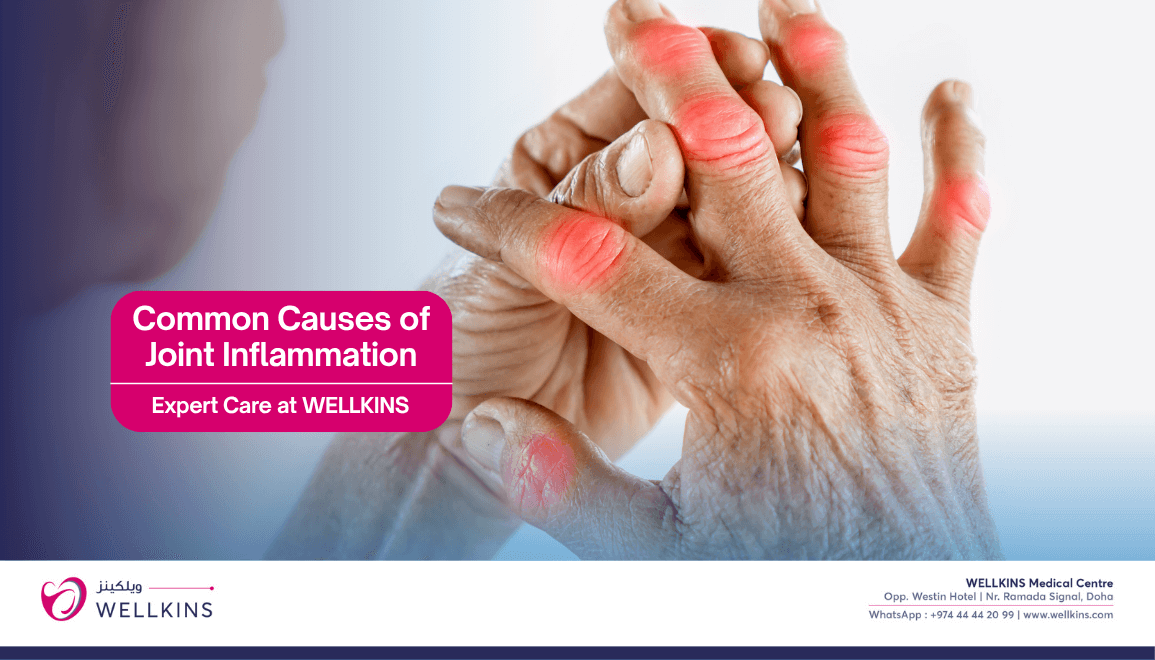Author: Dr. Reneesh (Consultant Orthopedic Surgeon – Wellkins Medical Centre)
Joint inflammation, medically known as arthritis or synovitis, is one of the most common causes of joint pain and stiffness seen in orthopedic practice. It can affect people of all ages from young athletes sustaining injuries to elderly individuals experiencing degenerative changes and may involve any joint in the body, from the spine to the small joints of the hands. At Wellkins Medical Centre, we treat joint inflammation as a serious condition, knowing that early recognition and appropriate management are absolutely key to preventing long-term damage, preserving mobility and maintaining a healthy, active lifestyle.
“Effectively treating chronic joint inflammation (arthritis) in Qatar requires moving beyond just symptom relief. It demands a complete, multifaceted approach targeting the underlying biological and mechanical triggers. This includes precise diagnosis (imaging/lab work), disease-modifying therapies, targeted physiotherapy and critical lifestyle modification. Since untreated inflammation causes progressive joint damage and disability, a proactive, structured plan integrating non-surgical care and patient education and timely surgery when necessary is essential for long-term joint preservation, maximized mobility and stopping the inflammatory cycle, not just masking episodic flare-ups.”
What Is Joint Inflammation?
Joint inflammation refers to swelling and irritation of the synovial membrane, the soft, specialized tissue that lines the joints. This lining produces fluid that lubricates the joint. When irritated, the inflammation leads to classic symptoms: pain, warmth, redness and restriction of movement. This swelling not only causes immediate discomfort but, over time, the inflammatory chemicals can aggressively break down the smooth cartilage and bone within the joint capsule, leading to permanent structural changes.
Common Causes of Joint Inflammation
Identifying the specific cause of inflammation is critical, as treatment differs drastically between mechanical wear-and-tear and autoimmune diseases.
1. Osteoarthritis (Degenerative Arthritis)
This is the most prevalent form, caused primarily by wear and tear of the cushioning joint cartilage with age or chronic overuse. It is common in weight-bearing joints like the knees, hips and spine.
Symptoms are typically characterized by pain during activity, stiffness after prolonged rest (like first thing in the morning) and gradually reduced mobility.
2. Rheumatoid Arthritis (RA)
RA is an autoimmune condition where the body’s own immune system mistakenly attacks the lining of its joints, treating them as foreign invaders. It usually affects multiple joints symmetrically (both hands, both wrists, both knees). Characteristic
symptoms include significant swelling, profound morning stiffness (lasting over an hour) and generalized fatigue.
3. Gout and Pseudogout
These conditions are caused by crystal deposition inside the joint fluid and tissues. Gout involves the sharp deposition of uric acid crystals, while pseudogout involves calcium pyrophosphate crystals.
Symptoms are sudden, excruciatingly severe pain with rapid swelling, often starting in a single joint, most commonly the big toe, ankle, or knee.
4. Infective (Septic) Arthritis
This type is caused by a bacterial or viral infection that has reached and multiplied within the joint space.
Symptoms: It usually presents with severe, debilitating pain, significant redness, high fever and the inability to move or bear weight on the joint. Septic arthritis is a medical emergency requiring immediate treatment to save the joint.
5. Post-Traumatic or Reactive Arthritis
This inflammation can occur after a direct injury to the joint (post traumatic arthritis) or sometimes following an infection elsewhere in the body (reactive arthritis, e.g., following a gut or urinary infection). It may commonly affect larger joints like the knees, ankles, or wrists.
6. Autoimmune and Connective Tissue Disorders
A range of systemic diseases including lupus, psoriatic arthritis, or ankylosing spondylitis can cause chronic joint inflammation as part of the overall disease process, often requiring systemic rheumatological management.
Investigations
A proper diagnosis is achieved through a detailed clinical history, physical examination and specific laboratory and imaging tests conducted at Wellkins.

Blood Tests: These non-invasive tests help determine the inflammatory status and identify specific disease markers: ESR and CRP levels help quantify general inflammation;
Rheumatoid factor (RF) and Anti-CCP: are specific to rheumatoid arthritis; Uric acid levels are checked for gout; and ANA and HLA-B27 may be used to screen for other autoimmune conditions.
Joint Aspiration (Arthrocentesis): This procedure involves safely drawing a small sample of fluid directly from the inflamed joint. The fluid is then analyzed under a microscope to definitively identify any bacterial infection or the presence of crystals (uric acid or calcium pyrophosphate).
Imaging:
- X-rays are used to detect long term structural damage like joint space narrowing, bone erosions, or osteophytes (bone spurs).
- Ultrasound or MRI provide more detailed visualization of soft tissues, helping us assess synovial thickening and early cartilage damage that might not appear on a standard X-ray.
Treatment Approach
The treatment approach is always multi-faceted, tailored to the underlying cause of the inflammation and focused on controlling pain and preserving joint function.
1. Medical Management
This is usually the first line of defense: Anti-inflammatory medications can control pain and swelling. Disease modifying agents (DMARDs) are used for autoimmune arthritis to quiet the immune system. Steroids can be given orally or as powerful intra-articular injections to control severe localized inflammation. Specific treatments like antibiotics are necessary for infective arthritis and uric acid–lowering drugs are critical for managing gout.
2. Lifestyle and Dietary Measures
These measures support medical treatment and improve long-term outcomes: Maintain a healthy weight to significantly reduce the load on major weight-bearing joints. Include anti-inflammatory foods in your diet, such as fatty fish, nuts, olive oil and leafy greens. For gout specifically, stay hydrated and strictly limit red meat, alcohol and sugary foods which can trigger crystal formation.
3. Surgical Options
Surgery is considered when inflammation leads to irreversible damage or persistent mechanical issues: Arthroscopic debridement may be performed in cases of severe, persistent synovitis that does not respond to medication. Joint replacement (arthroplasty) is reserved for advanced osteoarthritis or irreversible joint damage to restore function and eliminate pain.
Prevention Tips
You have significant control over your joint health. Incorporate these preventative habits into your life to minimize risk.
1. Regular Exercise
Engage in low-impact activities like swimming, cycling, or yoga. These exercises help strengthen the muscles surrounding the joint without placing excessive impact stress on the cartilage.
2. Maintain Healthy Weight
Weight management is paramount. Carrying extra body mass places enormous, damaging pressure on weight-bearing joints such as the knees and hips, accelerating wear and tear.
3. Avoid Repetitive Strain
Be mindful of your body mechanics. Modify work and sports activities to prevent overuse injuries and use ergonomic tools when necessary to protect smaller joints like the wrists.
4. Adequate Rest and Early Treatment
Never ignore persistent joint pain or swelling. Provide adequate rest during acute flair ups and recognize that early diagnosis by a specialist is the only way to prevent severe long-term complications.
5. Balanced Diet
Consume a diet rich in calcium and vitamin D for bone strength and include omega-3 fatty acids to benefit overall joint and soft tissue health.

Take-Home Message
Joint inflammation is not just an inevitable sign of aging it can occur due to multiple, treatable underlying causes, including autoimmune conditions, infections and metabolic disorders like gout. Recognizing that prompt evaluation is crucial can significantly change the course of the disease. At Wellkins Medical Centre, we can help you accurately identify the root cause, control symptoms effectively and preserve long-term joint function. We utilize advanced diagnostic tools and personalized treatment plans because we firmly believe that early diagnosis, precise medical intervention and diligent lifestyle modification are the best tools to protect your joints for life.
To book an appointment at Wellkins Medical Centre: https://wellkins.com/visit







